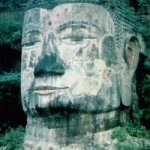The Great Wall of China isn’t the only giant historic site in China. In the Mount Emei Scenic Area, near the city of Leshan in the Sichuan province, you’ll find Leshan Dafo, or the Leshan Giant Buddha.
This seated stone sculpture was carved from a cliff face during the Tang Dynasty. It was the brainchild of the Chinese monk Haitong, who believed the giant religious carving would calm the area’s rivers. It seems he may have been right. Today the Minjiang, Dadu, and Qingyi rivers flow gently by the Giant Buddha’s feet. Skeptics may say the stone used to create the Buddha found its way into the waters, thereby altering their currents. But true believers feel it was the Buddha’s religious influence that made these waters safe for ships.
The enormous size of the Buddha renders tourists awestruck. His head reaches the top of the cliffs. The smallest toenail on his eight-meter feet can easily hold a seated person. His 28-meter hands have three-meter long fingers.
But the Leshan Buddha isn’t just large; it’s also an impressive feat of early architecture. His coiled hair features more than 1000 buns. Hidden gutters and channels scattered behind his ears, in his arms, and the folds of his clothing carry rainwater. This mechanism, which keeps the inner parts dry, has helped protect the Leshan Buddha for thousands of years.
However, the efforts of the early craftsman couldn’t save the Leshan Buddha from the modern world. Air pollution and acid rain caused sooty marks and erosion, although the site has been recently been restored.
Ferries traveling to Leshan Port to Yibin City, Luzhou City and Chongqing City all bypass the Leshan Giant Buddha site. Alternatively, tourists can catch a train from Leshan to Emei station. This is located about six miles from the Mount Emei Scenic Area.
